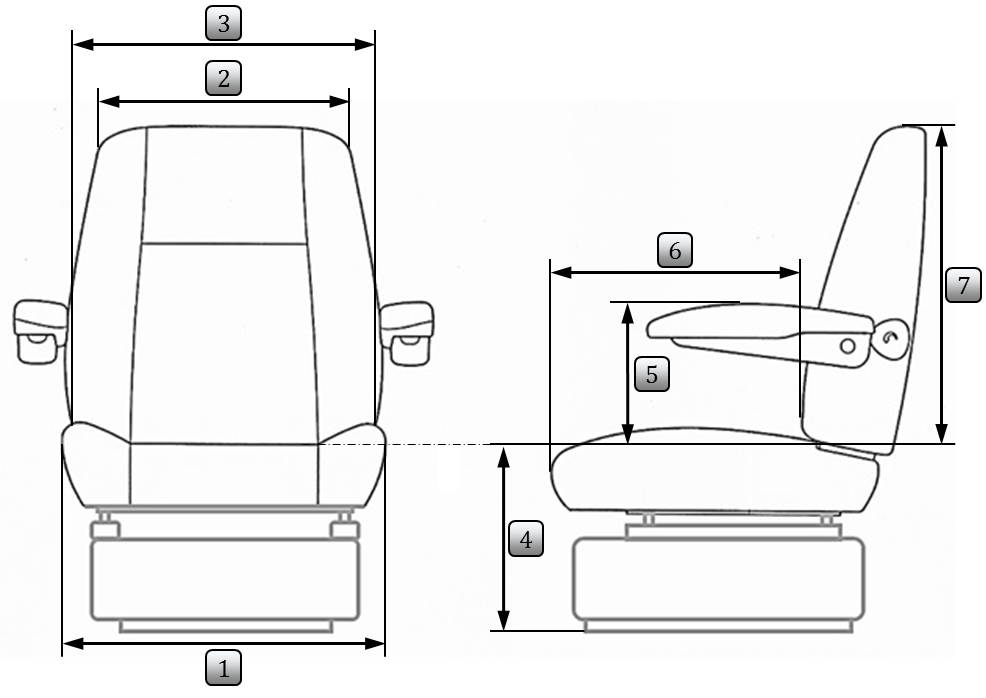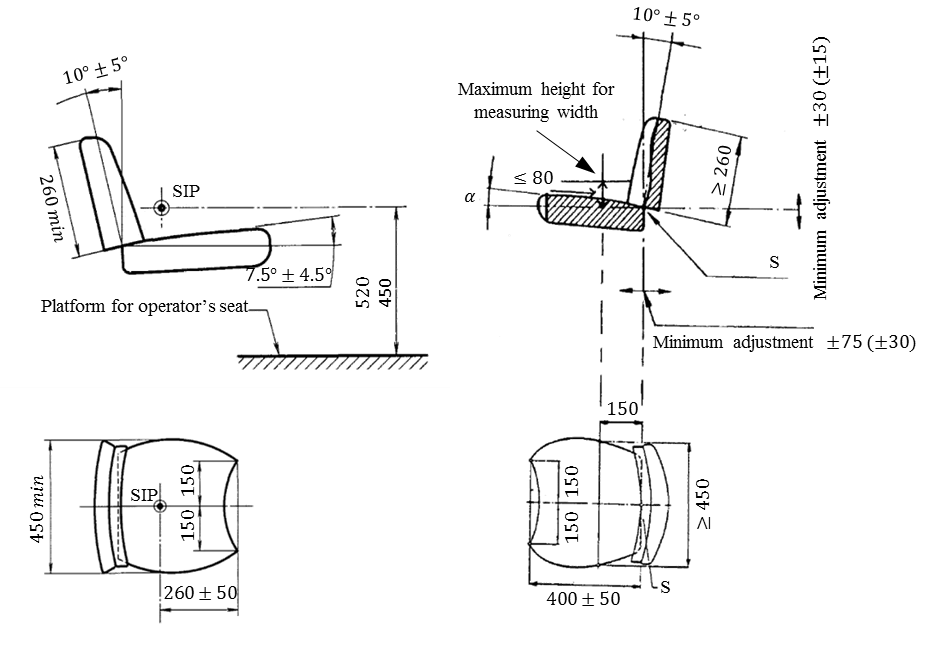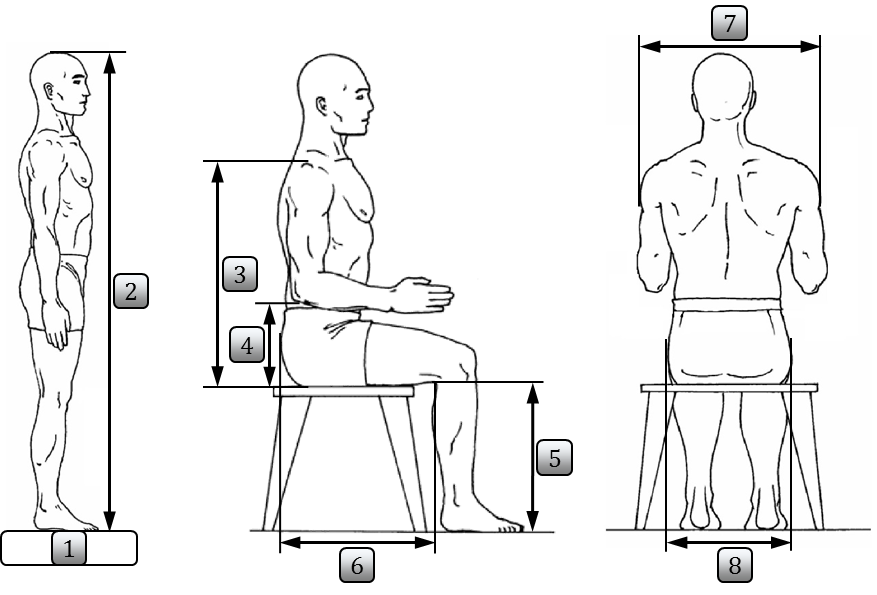







































BibTeX | RIS | EndNote | Medlars | ProCite | Reference Manager | RefWorks
Send citation to:
URL: http://journal.iehfs.ir/article-1-706-en.html
2- Associated Proffesor, Department of Biosystems Engineering, Faculty of Agriculture, University of Tabriz, Tabriz, Iran ,
3- Associated Proffesor, Department of Occupational Health, Faculty of Health, Tabriz University of Medical Sciences, Tabriz, Iran
✅ The dimensions of available combine harvester seats are not suitable for Iranian population. However, considering the anthropometric dimensions of operators can improve the seats ergonomically. It should be noted that a design based on corresponding national and international standards cannot guarantee the geometrical accommodation of seats.
In addition to all the life-threatening dangers of working with agricultural machines [1], vibrations [2], noise [3], dust, sun, rain [4], a large number of control levers and the high force required to activate them [6, 5] have made the condition of working with these machines, ergonomically unfavorable.. For ergonomic improvement of these machines, several factors should be considered among which dimensional accommodation has the greatest importance [7]. The proper matching of machine workspace with anthropometric characteristics of operator can influence the magnitude and pattern of loads imposed on the body structure [8], energy consumption [9], and operator’s effort, stress, efficiency, safety, and comfort [10].
In self-propelled agricultural machinery, the seat is an interface between the biomechanical system of human body and the mechanical system of machine [11]. Back pain due to long-term sitting is identified as an occupational disorder among the operators of agricultural machinery [12]. Pressure distribution at the interface of seat and operator’s body is one of the main factors of discomfort [13]. Non-uniform pressure distribution can increase the maximum amount of stress on body tissues and lead to discomfort [14]. Studies have revealed that the seat dimensions can affect the pressure pattern. Tewari and Prasad (2000) determined the most suitable dimensional parameters of tractor seat via investigating the pressure distribution pattern on an experimental seat [15]. Yadav (2012) offered new values for seat dimensions including seat pan height, seat pan width, seat pan depth, armrest height, and seat pan and backrest inclination angles in order to increase the comfort, safety, and efficiency in tea plantations [16]. The results of ergonomical assessment of common agricultural tractors in Iran indicated that a change in seat pan depth and longitudinal adjustment could increase comfort and accessibility to control tools, respectively [17].
Harvesting combine is one of the main agricultural machines playing a key role in cereal production such as wheat, barley, and corn. Evaluation of the possible mismatch between seat dimensions of existing agricultural combines and anthropometric characteristics of Iranian operators indicated that these seats are unsuitable for user population and there is a considerable mismatch for some dimensions such as seat height. New proposed dimensions increased the match percentages to a range of 77% to 100% [18].
In Iran, the lack of the physical characteristics data of target population has been stated as the main reason of inattention to ergonomic principles in agricultural machines [6]. Considering the vastness of Iran and ethnic diversity in it, different studies in various regions of country are basically necessary for an ergonomic improvement in these machines. In the current study, the dimensional accommodation of seat has been investigated on two models of common harvesting combines (John Deere 955 and John Deere 1055) in one of the wheat producing areas of Iran. The match/mismatch percentage of each seat dimension has been calculated and finally a new set of seat dimensions have been proposed in order to increase the match percentages. It is hoped that the results of this study would be considered by designers, manufacturers, and managers.
Bijar, the widest county of Kurdistan province, is known as the “Cereal Warehouse” in the west part of Iran due to high wheat production. According to the obtained information of Agricultural Jihad Management Office of Bijar (AJMOB), there were a total of 252 combines throughout the central district of the county in 2017 [19]. Sample size was calculated based on the Cochran’s formula (Eq. (1)) equal to 153 [20].

Where z is the selected critical value of desired confidence level (1.96 for 95% confidence level), p is proportion in the target population estimated to have a particular characteristic (0.5), e is the degree of accuracy required (0.05), N is total population size, and n is the sample size.
With regard to the possible problems during data collection process, the sample size was considered equal to 160. Finally, the data of 156 subjects were successfully recorded and used for the statistical analysis. When the study protocol was approved by the ethical review committee of University of Tabriz, the researchers were introduced to AJMOB for field studies. Participants were selected randomly among the clienteles of AJMOB and Agricultural Service Centers (ASCs). Anthropometric dimensions were measured by a team of three professional persons. It is noticeable that the participation was completely voluntary and without any stipend. All the participants were males and their ages ranged from 22 to 69 years.
Eight useful anthropometric dimensions (Figure 1 and Table 1) were measured using a traditional anthropometry set including a four-piece portable stadiometer which could be used as caliper (Galaxy Informatics), a body fat scale (Sanitas), and a height adjustable chair. The measurement resolution of stadiometer and body fat scale were 1 mm and 0.1 kg, respectively. Collected data were transmitted to computer and statistically analyzed using SPSS v.16 (SPSS Inc., Chicago, Ill., USA). Minimum, maximum, mean, standard deviation (SD), standard error of the mean (SEM), coefficient variation (CV), 5th percentile, and 95th percentile values were calculated.
Figure 1. Anthropometric dimensions measured in the study: 1. Weight, 2. Stature, 3. Shoulder height (Acromial), 4. Elbow rest height, 5. Popliteal height, 6. Buttock-popliteal length, 7. Shoulder breadth (Bideltoid), 8. Hip breadth
Table 1. Definition ofmeasured anthropometric dimensions [21]
| Anthropometric Dimension | Definition |
| Weight | The weight of the subject |
| Stature | The vertical distance from a standing surface to the top of the head |
| Shoulder height (Acromial) | The vertical distance between a sitting surface and the acromion landmark on the tip of the right shoulder |
| Elbow rest height | The vertical distance between a sitting surface and the olecranon landmark on the bottom of the flexed right elbow |
| Popliteal height | The vertical distance from a footrest surface to the back of the right knee (the popliteal fossa at the dorsal juncture of the right calf and thigh) |
| Buttock-popliteal length | The horizontal distance between a buttock plate placed at the most posterior point on either buttock and the back of the right knee (the popliteal fossa at the dorsal juncture of the calf and thigh) |
| Shoulder breadth (Bideltoid) | The maximum horizontal distance between the lateral margins of the upper arms on the deltoid muscles |
| Hip breadth | The distance between the lateral points of the hips or thighs (whichever are broader) |
In order to seat evaluation, seven seat dimensions were selected (see Figure 2). The value of these dimensions for studied combines have been given in Table 2.

Figure 2. Studied seat dimensions: 1. Seat width, 2. Upper backrest width, 3. Lower backrest width, 4. Seat height, 5. Armrest height, 6. Seat depth, 7. Backrest height
Table 2. Seat dimensions of studied combines [18]
| Dimension | Combine model | |
| JD 955 | JD 1055 | |
| Seat width (mm) | 470 | 470 |
| Upper backrest width (mm) | 360 | 360 |
| Lower backrest width (mm) | 419 | 420 |
| Seat height (mm) | 511 | 481 |
| Armrest height (mm) | 242 | 250 |
| Seat depth (mm) | 420 | 461 |
| Backrest height (mm) | 421 | 421 |
There is no criteria for evaluation of combine seat, except the standards associated to seat dimensions of agricultural machinery shown in Figure 3 [22-24]. Iranian national standards are direct translation of ISO standards and ISO standards are primarily based on the data of Western/European population [11]. Since there is a potential difference between the anthropometric dimensions of different populations, it is possible that ISO standards would not be suitable to dimensional evaluation in Iran. Therefore, in this study dimensions of combine seats are evaluated based on logical mathematical equations described in literature and compared with recommended ranges in associated standards.

Figure 3. Recommended seat dimensions for agricultural machinery. Right: 22; Left: 23, 24. Dimensions are in mm.
According to Researchers seat width should be wider than hip breadth, considering the clearance for clothing and lateral movement [25, 26]. Seat width should be accommodated with the maximum value of hip breadth [27]. While wider seats may create no problem ergonomically, it is possible that would not be applicable due to space limitations. In a compromise between dimensional accommodation and space economy, Eq. (2) is recommended to calculate the seat breadth [28].
HB <= SW <= 1.3HB (2)
Where HB is hip breadth and SW is seat width.
Seat backrest should be designed so that the spine maintain in relax posture. Since the tractor operator’s shoulders should be free to monitor tools at the rear of the tractor, the trapezoidal shape seat backrest with smaller width on the upper part may be more suitable for tractor seat [11]. So, upper and lower backrest width are calculated using respectively equations (3) and (4) [27].
UBW <= ShB-30mm (3)
1.1HB <= LBW <=1.3HB (4)
Where UBW is upper backrest width, SB is shoulder breadth, HB is hip breadth, and LBW is lower backrest width.
Seat height is usually considered less than popliteal height [29]. Some researchers report that the seat height should be between 88% and 95% of popliteal height [30] and some others suggest a range from 80% to 99% [31]. However, in some studies it is declared that seat height should be adjusted so that the lower leg forms an angle from 5 to 30 degrees relative to the vertical direction and the shin constitutes an angle between 95 and 120 degrees relativ to the thigh. In this study, Eq. (5) is used to evaluate the seat height in which a 2-cm correction factor is added to popliteal height to considering the effect of shoe sole height [18, 32].
(PH+20mm) cos 30° <= SH <= (PH+20mm) cos 5° (5)
Where PH is popliteal height and SH is seat height.
Almost all researchers unanimously suggest that the armrest height should not be adjusted lower than elbow height. However, there is some disagreement on the maximum allowed height [18, 25, 33]. Some researchers conclud that the armrest should be 5 cm higher than the elbow [34]. However, parcells et al. (1999) revealed that the armrest height should be adjusted based on flexion and abduction angles of the shoulder. They obtain an equation as Eq. 6 in which the maximum acceptable flexion and abduction angles are considered equal to 25 and 20 degrees, respectively [31]. This equation is used in the current study.
ERH <= ARH <= 0.8517ERH + 0.1483ShH (6)
Where ERH is elbow rest height, ARH is armrest height, and ShH is shoulder height.
It is evident from the literature that the seat depth should not be more than the buttock-popliteal length [18, 25, 32, 35]. Parcells et al. (1999) define the value of 80% to 95% of buttock-popliteal length as a suitable seat depth [31] and Gouvali and Boudolos (2006) increase the upper bound to 99% [28]. In this study, the seat depth is evaluated based on Eq. (7) which has been used in previous studies [36, 37].
0.8BPL <= SD <= 0.95BPL (7)
Owing to tractor operator requirements such as free mobility of the arms and shoulders, the backrest height should be below the scapula [27]. Accordingly, Eq. 8 is used to evaluate the backrest height which adjust the upper edge of the backrest lower than or at most on the upper edge of the scapula [28].
0.6ShH <= BH <= 0.8ShH (8)
Where ShH is shoulder height and BH is backrest height.
The descriptive statistics of anthropometric dimensions (including minimum, maximum, mean, SD, SEM, CV, 5th percentile, and 95th percentile) are summarized in Table 3. The match and mismatch percentages between seat dimensions and the corresponding anthropometric dimensions are summarized in Table 4.
Table 3. Anthropometric dimensions of Iranian male agricultural combine operators (n=156)
| Parameter | Minimum | Maximum | Mean | SD | SEM | CV | Percentile | |||||||||||||||||||||||||
| 5th | 95th | |||||||||||||||||||||||||||||||
| Weight (kg) | 48.7 | 111.7 | 75.0 | 12.4 | 1.00 | 16.60 | 54.5 | 95.5 | ||||||||||||||||||||||||
| Stature (mm) | 1595 | 1875 | 1717.4 | 63.9 | 5.11 | 3.72 | 1612.3 | 1822.4 | ||||||||||||||||||||||||
| Shoulder height (Acromial) (mm) | 527 | 685 | 600.4 | 31.3 | 2.50 | 5.21 | 548.9 | 651.8 | ||||||||||||||||||||||||
| Elbow rest height (mm) | 159 | 315 | 235.8 | 31.4 | 2.52 | 13.33 | 184.1 | 287.4 | ||||||||||||||||||||||||
| Popliteal height (mm) | 355 | 495 | 425.7 | 23.9 | 1.91 | 5.62 | 386.4 | 465.1 | ||||||||||||||||||||||||
| Buttock-popliteal length (mm) | 439 | 569 | 496.8 | 27.3 | 2.18 | 5.49 | 451.9 | 541.6 | ||||||||||||||||||||||||
| Shoulder breadth (Bideltoid) (mm) | 375 | 527 | 447.7 | 27.5 | 2.20 | 6.14 | 402.4 | 492.9 | ||||||||||||||||||||||||
| Hip breadth (mm) | 299 | 435 | 369.9 | 26.1 | 2.09 | 7.04 | 327.1 | 412.8 | ||||||||||||||||||||||||
| Combine model | Seat dimension (see Figure 2) | |||||||
| 1 | 2 | 3 | 4 | 5 | 6 | 7 | ||
| JD 955 | High Mismatch (%) | 38.5 | 0.6 | 2.6 | 99.4 | 3.8 | 1.3 | 0.0 |
| Low Mismatch (%) | 1.3 | 0.0 | 33.3 | 0.0 | 38.5 | 12.8 | 0.0 | |
| Match (%) | 60.3 | 99.4 | 64.1 | 0.6 | 57.7 | 85.9 | 100.0 | |
| JD 1055 | High Mismatch (%) | 38.5 | 0.6 | 2.6 | 93.6 | 9.6 | 35.3 | 0.0 |
| Low Mismatch (%) | 1.3 | 0.0 | 30.1 | 0.0 | 30.1 | 0.0 | 0.0 | |
| Match (%) | 60.3 | 99.4 | 67.3 | 6.4 | 60.3 | 64.7 | 100.0 | |
| High mismatch indicates that the seat dimension is greater than the maximum allowed value. Low mismatch indicates that the seat dimension is less than the minimum allowed value. |
||||||||
In order to reach the match between a seat dimensions with a range of corresponding anthropometric dimension, based on a special equation, two conditions should be met. The seat dimension should be less than the upper bound of equation for minimum value of anthropometric dimension and the seat dimension should be more than the lower bound of equation for maximum value of anthropometric dimension. Accordingly, required conditions to accommodation of 90% between seat dimensions and corresponding anthropometric dimension(s) have been summarized in Table 5.
Table 5. Required conditions to accommodation of 90% between seat dimensions and corresponding anthropometric dimension(s)
| Seat width | Upper ackrest width | Lower ackrest width | Seat height | Armrest Height | Seat depth | Backrest height |
| ≤425.2 | ≤372.4 | ≤425.2 | ≤404.9 | ≤238.2 | ≤429.3 | ≤439.1 |
| ≥454.1 | ــــــ | ≥454.1 | ≥420.1 | ≥287.4 | ≥433.2 | ≥391.1 |
In the case of a seat dimension, if it is possible to satisfy two conditions simultaneously, there is a constant suitable value for seat dimension which can guarantee
| Seat width | Upper ackrest width | Lower ackrest width | Seat height | Armrest Height | Seat depth | Backrest height | |
| Suggested value (mm) | 440 | 370 | 440 | 410 | 260 | 430 | 415 |
| High Mismatch (%) | 11.5 | 3.2 | 11.5 | 8.3 | 17.3 | 5.1 | 0.0 |
| Low Mismatch (%) | 12.8 | 0.0 | 12.8 | 10.9 | 20.5 | 6.4 | 0.0 |
| Match (%) | 75.6 | 96.8 | 75.6 | 80.8 | 62.2 | 88.5 | 100 |
As it could be seen in Table 3, the mean of stature and weight of Iranian combine operators were 1717.4 mm and 75.0 kg, respectively. A comparison of the mean values of the stature indicated that they were taller than Indian, Korean, Chinese, Taiwanese, and Japanese and shorter than British, Germa n, and American population [38]. Also, Iranian combine operators were 4.3% taller and 26.9% heavier than Indian farmers [39], 1.2% shorter and 3.8% heavier than Nigerian farmers [40], 8.0% taller and 34.6% heavier than Indonesian farmers [41], and 4.9% taller and 15.9% heavier than Thai farmers [42].
The most and the least accommodations were obtained for backrest height and seat height, respectively. The accommodation of seat width in the current study was less than the calculated accommodation in Ghaderi et al., (2014) [18]. Although this dimension was narrow for almost no one, it was wide for 38.5% of population and it could create some spatial problems. What was said about seat width was also true about lower backrest width. Due to the lack of lower bound in the equation associated to upper backrest width, the accommodation of this seat dimension was near to 100% for both combine models. In agreement with the previous study, seat height of both seats were unsuitable for more than 90% of operators which can lead to some problems [18]. A too high seat can increase pressure on the underside of the thigh. This condition may decrease blood circulation to the lower legs and lead to discomfort [11, 35]. The associated standards allow that the height of seat index point (SIP), the distance between front edge of seat pan and SIP, and the inclination of backrest would be considered respectively equal to 520 mm, 310 mm, and 11 degrees. Under such conditions, the seat height would be calculated equal to 579 mm which is considerably more than the maximum amount of popliteal height and would be unsuitable for all studied operators [22-24]. So, it is clearly obvious that observation of these standards cannot guarantee the accommodation of seat dimensions for Iranian population. Although the accommodation of armrest height in this study was more than that of similar study [18], the match percentage of a constant value for this dimension would be the least among dimensions (Table 6). Match percentage of seat depth in JD 955 is more than that of JD 1055. A too deep seat can eliminate the support of backrest and increase pressure on the popliteal surface which can disturb blood circulation. On the contrary, a too short seat can put extra-pressure on the back of the thighs [43]. The associated standards can be followed in such a way that the seat pan would be shallow for all studied operators [22-24]. It can prove the unsuitability of these standards for seat design in Iran. In both combine models, only backrest height was suitable for all operators. Associated standards suggest that this dimension should be more than 260 mm which can be followed in such a way that this dimension would be unsuitable for all operators.
A comparison between Table 4 and Table 6 indicated that the proposed seat dimensions increase the accommodation in all dimensions except upper backrest width. However, the match percentage of new upper backrest width is more than 95% and is satisfying for a proper design. Considering the lower backrest width, the upper backrest width equal to 370 mm seems more suitable esthetically. As mentioned above, the wider seat would not be ergonomically inappropriate. If it is possible spatially and esthetically, it is suggested that the seat width would be considered more than 450 mm in order to accommodate more than 90% of users. So, it can be said that the recommended amounts of seat width in associated standards are suitable ergonomically, but the esthetical and spatial issues are ignored in them [22-24]. A decrease in seat height increased the accommodation of this dimension to more than 80%. However, an 80 mm adjustability for this dimension can increase the accommodation to 100%. Also, the new amount of seat depth increased the accommodation to near to 90%. While an increase in armrest height by selecting the new value for it, its accommodation is not satisfying. If 90% accommodation of this dimension is very important, it should be considered adjustable. Generally, the balance between high mismatch and low mismatch indicate that the proposed dimensions are near to optimal values for target population.
The results of this study revealed the necessity of attention to ergonomic issues in agricultural machinery and review of associated standards. While the current study is one of the few studies in field of ergonomics of common agricultural machinery in Iran, only a restricted area of Kurdistan province is considered in it. Considering the vastness of Iran and ethnic diversity in it, the results of the study may not be generalizable to the country. It is hoped that similar studies would be conducted in other parts of the country and the database of anthropometric characteristics needed for design of agricultural machines including combine harvesters would be completed. It is noticeable that in this study a limited number of seat dimensions are discussed. Considering more dimensions and using new methods can lead to more optimal and complete results.
In spite of the importance of ergonomic issues in agricultural machinery, review of literature indicated that the studies in this area were very limited especially in Iran. In the current study, the accommodation of seat dimensions with the anthropometric characteristics of Iranian operators were evaluated in two models of common harvesting combines. The results indicated that some of seat dimensions were very unsuitable for Iranian population. However, the new set of seat dimensions could increase the accommodation without a considerable economic change. It was possible to improve the seat of harvesting combines ergonomically and increase the level of health, safety, and comfort. It should be noted that following the associated standards would not necessarily lead to a proper design of agricultural machinery. A successful design needs a database of physical characteristics of target population.
This work was conducted in space provided by Agricultural Jihad Management Office of Bijar. This office and the operators participating in the study are highly appreciated.
The authors declared no conflict of interest.
Received: 2020/04/15 | Accepted: 2020/06/6 | ePublished: 2020/06/6
| Rights and permissions | |
 |
This work is licensed under a Creative Commons Attribution-NonCommercial 4.0 International License. |









